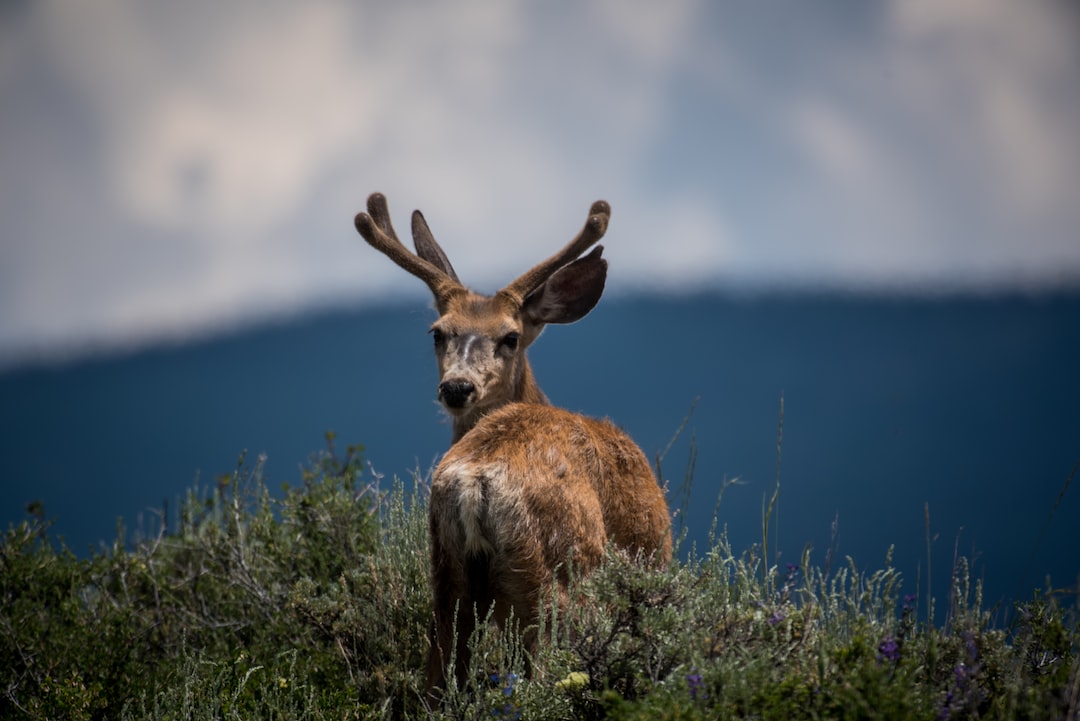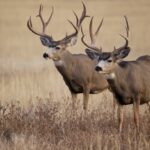It’s a question many hunters and outdoors enthusiasts have asked.
From the structure of their bones to how long they remain in velvet, understanding what factors contribute to the shedding process can help you increase your chances of finding those elusive sheds.
What are deer antlers made of? How do factors such as age and nutrition influence growth patterns? When is it likely that a buck will drop its horns during the year? We’ll explore all this – plus tips for finding them – so you know when and where to look when trying to answer why deer shed their antlers.
What are Deer Antlers Made Of?
Deer antlers are a unique and fascinating part of the deer family.
They are made up of bone, cartilage, and other connective tissues that grow from the skull of male deer species. The growth cycle of antlers is one of nature’s most amazing processes, with new antlers growing each year in a predictable pattern.
Anatomy Of A Deer Antler:
Deer antlers consist mainly of bone covered by velvet-like skin called “velvet” which is rich in blood vessels to help nourish the growing bone.
As the antler grows it hardens and becomes solid ivory-colored bone with ridges or points along its length.
At maturity, some species may have multiple points on their headgear while others will only have one main beam with several tines branching off it.
Learn more about what deer tracks look like.
Composition Of A Deer Antler:
The composition of deer antlers varies depending on species but generally consists mostly of calcium phosphate minerals such as hydroxyapatite and whitlockite combined with collagen fibers for strength and flexibility.
This combination gives them an impressive tensile strength that can support large amounts weight without breaking or bending easily when under pressure from predators or during fights between males competing for mates during mating season.
During springtime when days become longer due to increased sunlight exposure, hormones cause new tissue to form at the base (or pedicle) where the old set was attached before they are shed off after mating season ends in late summer/early fall months each year.
This process is known as “casting” or “shedding” depending on how quickly they come off naturally versus being broken off by another animal during fighting over territory or mating rights within their herd groupings throughout various regions across North America annually.
Understanding the composition and anatomy of deer antlers is key to understanding how they grow.
Additionally, there are several environmental factors that play a role in determining the size and shape of antlers, which will be discussed further in the next section.
Factors That Determine Antler Growth
Genetics play a major role in determining antler growth. The genetic makeup of the deer determines how many points, size, and shape of the antlers will be.
This is why some bucks have larger racks than others; it’s all predetermined by their genes. Nutrition and diet are also important factors when it comes to antler growth. A healthy diet that includes plenty of minerals, vitamins, proteins, and carbohydrates helps ensure that the buck has enough nutrients for its body to produce quality antlers.
Age and health of the deer also affects antler growth as older bucks tend to have bigger racks due to years of proper nutrition and good genetics.
Finally, seasonal changes in light and temperature can influence how quickly or slowly a buck’s rack grows each year as colder temperatures slow down development while warmer temperatures speed up development.
By understanding the various factors that determine antler growth, we can gain insight into why a deer’s antlers may look different from one year to the next. From there, we can explore how long a buck is in velvet and learn more about the shedding process.
How Long Are Deer in Velvet?
The velvet shedding process is a natural part of the deer’s life cycle. It typically begins in late summer and can last anywhere from two to four weeks, depending on the region and climate. During this time, bucks will rub their antlers against trees or other objects to remove the velvet covering that has grown over them during the spring months.
Once all of the velvet has been removed, it is replaced by hard bone tissue which gives the antlers their strength and durability. The entire process usually takes about three weeks for an adult buck but can take longer for younger animals as they are still growing into their antlers.
Signs that a buck is ready to shed its velvet include increased rubbing behavior on trees or other objects as well as signs of irritation around his face where he may be trying to scratch off some of the remaining velvet with his hooves or teeth.
Additionally, you may notice small pieces of fur or hair stuck in between his antler points indicating that he’s beginning to shed his velvet coat.
Finally, when looking for freshly dropped antlers it is important to remember that bucks tend to drop them in areas where there is less human activity such as thick brushy areas near water sources like ponds and streams.
However, they can also be found along trails used by hikers and hunters alike, so do not forget to check those spots too.
Once the velvet shedding process has been completed, bucks are ready to find new habitats and common areas to shed their antlers. Now let’s explore where deer typically shed their antlers in order to better understand this unique behavior.
Where Do Deer Typically Shed Their Antlers?
Deer typically shed their antlers in the late winter or early spring. The exact timing of when a deer will shed its antlers can vary by region and climate, but it usually happens between January and April.
Deer typically prefer to shed their antlers in open areas that are free from obstructions such as trees, brush, or other obstacles. This allows them to move freely without having to worry about becoming entangled on something while they’re shedding their antlers.
Common habitats for deer shedding include fields, meadows, pastures, clear-cuts, logged areas with young saplings growing back in place of the old trees; edges of forests near agricultural land or roadsides; and any area where there is ample space for a buck to maneuver around without hindrance.
When looking for sheds, you should focus your search on these preferred habitats as well as along trails leading into and out of these areas where bucks have been known to travel during the rut season (fall).
Additionally, look around water sources such as ponds or streams since deer often use these spots as resting places throughout the year. Lastly, don’t forget about bedding sites which are commonly used by bucks during colder months when they need extra warmth; these locations may also be good places to find sheds.
From the preferred habitats to common areas, understanding where deer typically shed their antlers can help you plan your next hunting trip. Now let’s look at when these antlers are actually shed – what time of year do deer usually drop them?
What Time of Year Do Deer Shed?
Deer antlers are an impressive and unique feature of the animal kingdom. Every year, deer grow a new set of antlers which they shed and regrow annually. Knowing when to expect this natural process is important for hunters who want to find freshly dropped antlers in the wild.
Timing of the Shedding Process:
The timing of when deer shed their antlers varies depending on location and climate, but typically occurs between late December through early April in North America.
Generally speaking, bucks will begin shedding their velvet-covered antlers shortly after Christmas with some variation based on region or weather conditions that can affect growth cycles. In colder climates, bucks may not drop their velvet until later in winter or even into springtime due to delayed growth from cold temperatures.
With the shedding process varying by region and climate, it is important to understand when deer typically shed their antlers in order to maximize your chances of finding them. With these tips for finding sheds, you can be sure to get the most out of your search.
You will want to make sure you have a good hunting boot paired with a quality hunting sock and be prepared to put in the miles.
Tips for Finding Deer Sheds
Scouting for Potential Areas to Search:
When looking for deer sheds, the first step is to scout potential areas. Look for places where deer are likely to bed down and feed. These areas should be near sources of food such as acorns, grasses, or agricultural fields.
Also look for travel corridors between feeding and bedding areas that could provide a good opportunity to find antlers. Pay attention to any signs of recent activity like tracks or droppings which can help you narrow down your search area even further.
Knowing When To Look For Freshly Dropped Antlers:
The best time to look for freshly dropped antlers is during late winter when bucks begin shedding their velvet-covered racks in preparation for the breeding season ahead.
This typically happens around February and March depending on your region’s climate conditions so keep an eye out at this time of year if you want the best chance at finding recently dropped sheds.
Technology has made it easier than ever before to locate potential shed hunting spots with GPS mapping apps like Google Earth Pro and satellite imagery services like TerraServer USA being available online free of charge.
With these tools, you can easily identify prime habitat types from home then head out into the field armed with more knowledge about where exactly those prime habitats are located, giving yourself a better chance at success.
FAQs in Relation to Why Do Deer Shed Their Antlers
Does shedding antlers hurt the deer?
No, shedding antlers does not hurt the deer. Antlers are composed of bone that is covered in a layer of velvet-like skin and fur.
When it comes time for the deer to shed their antlers, they do so naturally and without any pain or discomfort. The process typically takes several weeks as the velvet-like skin dries up and falls off before the antler itself detaches from its base on the animal’s head.
As such, there is no need to worry about whether or not this natural process causes any harm to our beloved wildlife species. However, pushing the animals around in their winter range can put unnecessary stress on the herds. Be mindful of the impact you have as you hike around.
What is the purpose of deer shedding their antlers?
The purpose of deer shedding their antlers is twofold.
Firstly, it allows the animal to shed its heavy headgear and reduce energy expenditure during the winter months when food is scarce.
Secondly, it serves as a signal for breeding season; males with larger antlers are more attractive to females and thus have an advantage in mating.
The process of shedding helps maintain genetic diversity by allowing different males to compete for mates each year. Ultimately, this ensures that only the strongest genes are passed on from generation to generation, ensuring healthy populations of deer in the future.
Do deer antlers get bigger each year?
Yes, deer antlers typically do get bigger each year. As the animal ages and matures, its antlers will grow larger in size.
This is due to an increase in testosterone levels during the spring and summer months which stimulates growth of the antler’s velvet covering and eventually leads to hardened bone structures with more points or tines.
It is important for hunters to be aware of this natural process as it can help them identify a mature buck from a younger one when out hunting.
What happens to deer antlers when they fall off?
When a deer sheds its antlers, the process is known as “casting”. The antlers fall off naturally and are replaced by new ones each year.
Depending on the location, these discarded antlers can be found in various places such as under trees or bushes, near water sources, or in open fields. Antler growth is highly dependent on nutrition and environmental factors so they vary greatly in size and shape depending on their age and where they were shed.
After being shed, some of these antlers may become food for scavengers like rodents or birds while others may simply decompose over time. Regardless, antlers are a valuable resource for hunters and outdoors enthusiasts who use them to craft tools or decorate their homes.
Conclusion
Deer typically shed their antlers during the winter months when velvet is no longer present.
The factors that determine antler growth and how long a deer stays in velvet vary from animal to animal, but with some research and patience you can find out where deer typically drop their antlers and increase your chances of finding them.
By understanding what deer antlers are made of, familiarizing yourself with the time of year they shed, and following our tips for finding sheds you’ll be able to locate those hard-to-find treasures in no time.



